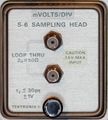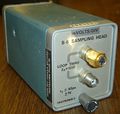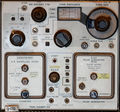S-6: Difference between revisions
No edit summary |
(Added link to local copy of instruction manual) |
||
| Line 11: | Line 11: | ||
* [http://w140.com/tek_s6.pdf Tektronix S-6 Manual (low quality, 1987, PDF)] | * [http://w140.com/tek_s6.pdf Tektronix S-6 Manual (low quality, 1987, PDF)] | ||
* [http://w140.com/TEK_S6_1983.pdf Tektronix S-6 Manual (high quality, 1983, PDF)] | * [http://w140.com/TEK_S6_1983.pdf Tektronix S-6 Manual (high quality, 1983, PDF)] | ||
* [[media:070-1128-01.pdf|S-6 Sampling Head Instruction Manual, Revised Aug 1985 (PDF, OCR)]] | |||
}} | }} | ||
The '''Tektronix S-6 Sampling Head''' plug-in is a 50 Ω feed-through unit with a rise-time of 30 ps and bandwidth of 11.5 GHz. | The '''Tektronix S-6 Sampling Head''' plug-in is a 50 Ω feed-through unit with a rise-time of 30 ps and bandwidth of 11.5 GHz. | ||
Revision as of 05:55, 3 February 2021
Template:Plugin Sidebar 2 The Tektronix S-6 Sampling Head plug-in is a 50 Ω feed-through unit with a rise-time of 30 ps and bandwidth of 11.5 GHz. It was introduced in 1971.
The S-6 provides two unterminated 50 Ω SMA connections in a loop-through configuration as is convenient for TDR applications. It is good practice to leave a termination resistor on the unit when unused to give some protection against electrostatic discharge.
Key Specifications
| Rise time | 30 ps |
|---|---|
| Bandwidth | 11.5 GHz |
| Operating input voltage range | 1 Vp-p |
| Maximum single sample step | 250 mV for less than 5% aberration |
| Maximum input voltage | ±5 VDC |
| Input impedance | 50 Ω (unterminated!) |
| Noise | < 5 mV of noise |
| Features |
|
Links
- S-6 internal photo and simulation
- Repairing an S-6 head (with internal photos)
- S-6 @ amplifier.cd 7S12 page
- S-6 @ barrytech.com
Pictures
-
S-6 front
-
S-6, entire plugin
-
S-6 sampling head and S-52 pulse generator head in a 7S12 TDR/Sampler plugin
-
S-6 with a black face plate
-
-
-
155-0053-00 hybrid sampling diode assembly
-
155-0053-00 hybrid sampling diode assembly (internal)
Measurements
-
Impulse taken with S6 sampling head. Every dot is equivalent to one sample taken, and combined on the CRT with a rate of app. 100 Hz. Bright dots are newer than dimmed ones.
-
Incident pulse from an S-52 (nom. < 25 ps) displayed by an S-6 head (nom. < 30 ps), both installed in a 7S12. Displayed rise time ~35 ps confirms spec.
-
"Self Portrait" of an S-6: A pulse reflected on the unterminated "through" path (approx. 120 ps one way)










